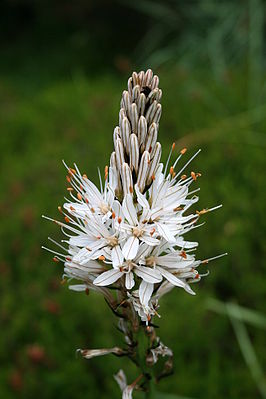White affodilla
| White affodilla | ||||||||||||
|---|---|---|---|---|---|---|---|---|---|---|---|---|

Asphodelus albus subsp. delphinensis |
||||||||||||
| Systematics | ||||||||||||
|
||||||||||||
| Scientific name | ||||||||||||
| Asphodelus albus | ||||||||||||
| Mill. |
The white affodill ( Asphodelus albus ) is a species of plant from the genus Affodill ( Asphodelus ) in the subfamily of the Affodil family (Asphodeloideae).
description
The white affodill is a perennial herbaceous plant that reaches heights of 30 to 120 cm. It has fleshy, beet-like thickened rhizomes . The stem is erect, tubular and mostly leafless. The basal leaves are gray-green in color, keeled and measure 15 to 60 × (0.5 to) 1 to 2 (to 3) centimeters.
A dense, unbranched or only a few short branches having inflorescence is formed. The membranous bracts are black-brown to dark brown. The hermaphrodite flowers are funnel-shaped. The tepals measure 15 to 24 × 2.5 to 5.5 millimeters and are white or pale pink in color with a darker median nerve.
The egg-shaped capsule fruits are (6.5 to) 8 to 10 (to 13) millimeters long.
The flowering period extends from May to July.
Occur diploid , tetraploid and hexaploid cytotypes with chromosome numbers of 2n = 28, 56 or 84.
Occurrence
The white affodilla occurs in the mountains of central and northern Spain as well as in western, southern and central France, northern Italy, southern Switzerland , Hungary and the western and central Balkan peninsula. It inhabits sunny meadows, rocky lawns, open trees and burns at altitudes from 0 to 2200 meters. It prefers nutrient-rich, chalky soil .
Systematics
The scientific name Asphodelus albus was first published by Philip Miller in 1768 . Four subspecies are distinguished from the white affodill:
- Asphodelus albus Mill. Subsp. albus : The capsules are short with a length of 6.5 to 10 (up to 11) mm, when young they are the only ones shiny dark green (not matt yellow-green) and with a three-lobed (not clipped) tip. The bracts are obsolete. This subspecies is diploid with a chromosome number of 2n = 28. It occurs in the north of the Iberian Peninsula and in western and central France.
- Asphodelus albus subsp. carpetanus Z.Díaz & Valdés : In contrast to the other subspecies, the rhizomes are not covered by fibers; the inflorescence has one to five branches more often than in the other subspecies. The inner bracts are very wide with 4 to 5.5 mm and remain on the ripe capsules for a long time. This subspecies is tetraploid with a chromosome number of 2n = 56. It occurs in central Spain in the Sierra de Francia and Sierra de Guadarrama mountains .
- Asphodelus albus subsp. delphinensis ( Gren. & Godron ) Z.Díaz & Valdés : The bracts remain on the ripe capsules for a long time. At the time of flowering, the bracts are usually longer than the flower stalks. This subspecies is tetraploid with a chromosome number of 2n = 56. It occurs in the Pyrenees , the Alps and in the mountains of the Balkan Peninsula .
- Asphodelus albus subsp. occidentalis ( Jordan ) Z.Díaz & Valdés : The bracts are obsolete. The fruit stalks are very long with 13 to 19 (up to 22) mm (with the other subspecies only up to 14 mm). Only in this subspecies are the bracts shorter than the flower stalks at flowering time. It is hexaploid with a chromosome number of 2n = 84. It occurs in northern Spain and western France.
use
The white affodilla is rarely used as an ornamental plant for borders, shrub beds and large rock gardens. It has been in culture since 1596 at the latest.
supporting documents
literature
- Xaver Finkenzeller, Jürke Grau: Alpine flowers. Recognize and determine (= Steinbach's natural guide ). Mosaik, Munich 2002, ISBN 3-576-11482-3 , p. 28 .
- Eckehart J. Jäger, Friedrich Ebel, Peter Hanelt, Gerd K. Müller (eds.): Excursion flora from Germany . Founded by Werner Rothmaler. tape 5 : Herbaceous ornamental and useful plants . Springer, Spektrum Akademischer Verlag, Berlin / Heidelberg 2008, ISBN 978-3-8274-0918-8 , pp. 728 .
Individual evidence
- ↑ a b c d e f g Zoila Díaz Lifante, Benito Valdés: Revisión del género Asphodelus L. (Asphodelaceae) en el Mediterráneo Occidental. In: Boissiera. Volume 52, 1996, pp. 88-103.
- ^ Philip Miller: The Gardeners Dictionary. 8th edition. John & Francis Rivington, London 1768 (online).
Web links
- Asphodelus albus Mill. In: Info Flora , the national data and information center for Swiss flora .